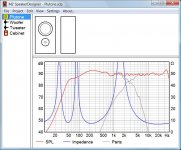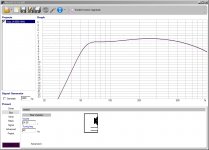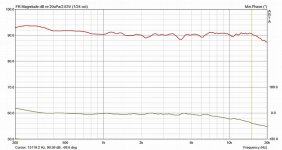The kit price is based on the parts cost in The Netherlands (where I live) - nothing extra added. They include 21% dutch sales tax. If sold outside the EU they are free from this sales tax.
What I meant to say is that your kit costs less that if I bought the parts separately in US. The kit adds the value of the crossover design, matched drivers, built and characterized filters.
Yup, no coil. Thanks ZvuThe peak 500-900Hz is a product of baffle step so the notch filter is necessary. He explains further in the text.
RC is not a notch filter.
Tonny will be visiting me this week
Waiting with bated breath! Did you guys have some fun last week?
I visited Tony last week and I actually bought it.
This is what I have been looking for.
Very smooth "weightless" treble with lots of details.
Firm bass from the woofer, where you could distinguish every note.
The speaker didn't highlight anything, it just played very neutral.
Very nice voice reproduction.
Nice coherenced sound from the drivers.
Most important is that this was optained with my own CD's with real music and not some fancy test CD's.
I'm looking very much forward to hear it in my own house when finished.
This is what I have been looking for.
Very smooth "weightless" treble with lots of details.
Firm bass from the woofer, where you could distinguish every note.
The speaker didn't highlight anything, it just played very neutral.
Very nice voice reproduction.
Nice coherenced sound from the drivers.
Most important is that this was optained with my own CD's with real music and not some fancy test CD's.
I'm looking very much forward to hear it in my own house when finished.
This is what I have been looking for.
That's great news for you! Congratulations, Tonny!
Thanks for the little review. Look forward to reading more comments from you after yours is born.
Now I have to decide without audition.
I was reading a useful Klippel paper on distortion in those sort of crummy little drivers they fit in phones and such.
The interesting conclusion was that the great distortion comes from cone excursion and mechanical losses which get highly non-linear. troels has specified a midwoofer with extremely low mechanical losses and a Qms around 10, which is good.
You can't go wrong with this speaker. Tony is the doyen of series filters, but this dabble with parallel looks good too. What's the worst that could happen? You just fit a slightly more complex BW3 crossover, which, of course is the most natural sound.
I have been reviewing my humblehomemadehifi downloads lately, and TBH, Tony knows a good driver when he sees one. Lol
The interesting conclusion was that the great distortion comes from cone excursion and mechanical losses which get highly non-linear. troels has specified a midwoofer with extremely low mechanical losses and a Qms around 10, which is good.
You can't go wrong with this speaker. Tony is the doyen of series filters, but this dabble with parallel looks good too. What's the worst that could happen? You just fit a slightly more complex BW3 crossover, which, of course is the most natural sound.
I have been reviewing my humblehomemadehifi downloads lately, and TBH, Tony knows a good driver when he sees one. Lol
Last edited:
Hello, I'm new on this thread. Took me some time to discover this.
The Plutone is indeed a special speaker. A set plays in my room since June and takes great care of a whole lot of music. Simplicity in a way that has been applied like this needs designers who really understand what's happening. Troels did a fine redesign of the basmid Simplicity in a way like this needs designers who really understand what's happening. and Tony made a very good match in speakers and filter selection.
The kit makes the preparation for building very easy. Braking in takes a bunch of hours.
Plutone's sound: neutral, detailed, dynamic, reproduction of the space and recording. Result: It pulls me into the music, I'm listening to musicians and forget about the rest.
The Plutone is indeed a special speaker. A set plays in my room since June and takes great care of a whole lot of music. Simplicity in a way that has been applied like this needs designers who really understand what's happening. Troels did a fine redesign of the basmid Simplicity in a way like this needs designers who really understand what's happening. and Tony made a very good match in speakers and filter selection.
The kit makes the preparation for building very easy. Braking in takes a bunch of hours.
Plutone's sound: neutral, detailed, dynamic, reproduction of the space and recording. Result: It pulls me into the music, I'm listening to musicians and forget about the rest.
With no offense whatsoever meant toward Tony, I doubt it, other than perhaps an oblique one i.e. BR with a lowish order filter. They seem rather different to me otherwise. Cabinet is larger, series filter at a different frequency to a different (large dome Seas) tweeter, so voicing will also be different, and it's specifically intended for corner placement. YMMV as always of course. They should both be excellent speakers. 
Last edited:
664/5000
This speaker seems to have everything I would like to hear.
Is it reasonable to buy the parts separately and deduce which with the 3 components of the crossover?
We have the following:
The breakpoint is 2.4K
Are only 2 inductors and a capacitor
Perhaps in a protoboard with cheap components can be done many tests at a low cost and measure the frequency response until the point.
Maybe you could deduct the Crossover by playing with a DSP Software or with an Electronic Crossover like the Behringer DCX2496
The value of the drivers is approximately US $ 1,500, that's a lot less than the $ 3,300 Kit with the original Crossovers
This speaker seems to have everything I would like to hear.
Is it reasonable to buy the parts separately and deduce which with the 3 components of the crossover?
We have the following:
The breakpoint is 2.4K
Are only 2 inductors and a capacitor
Perhaps in a protoboard with cheap components can be done many tests at a low cost and measure the frequency response until the point.
Maybe you could deduct the Crossover by playing with a DSP Software or with an Electronic Crossover like the Behringer DCX2496
The value of the drivers is approximately US $ 1,500, that's a lot less than the $ 3,300 Kit with the original Crossovers
Hi Damilan. Last summer I priced out buying the parts separately in US and found that Tony's kit is a pretty good price. Back then the kit cost ~$700 more, iirc, but better now with rising USD/EUR. Tony's design took a lot of effort which I would not want to duplicate myself. The drivers and XOs are matched, XO are built. Tony's brand benefits resale. So that all has value and I'm willing to pay for it. If I was in Europe I would also get his CNC flat pack kit. Plutone is definitely next in my speaker queue. I have DCX, imo, the SQ isn't good enough for drivers of this quality, and no match for the xo parts quality in this kit. ymmv
To be VERY honest, I really can't tolerate low order crossovers on the 8" paper bass, 1" tweeter idea. 
And I build these things...
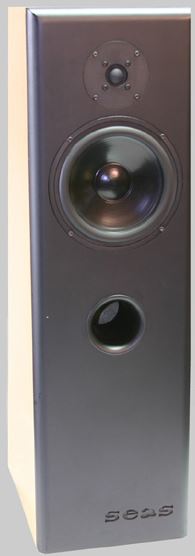
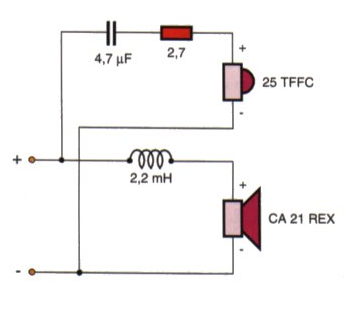
Those images are the old SEAS Njord kit, from back in the day when SEAS were rather good at building woofers with low mechanical loss aka high Qms. Which we believe (and Troels does...) is a GOOD THING these days.
I just know I'd like that speaker's sound for the first hour. Lively and musical. Then I'd start to notice some cone breakup from the bass with the low order filter which would kill the whole experience for me. Especially with dense complex classical music. And tweeter distortion might be an issue too, at high volume.
There's a reason HiFi exhibitors always demo with Jazzy Diana Krall music. And it's not an entirely honest one.
And I build these things...


Those images are the old SEAS Njord kit, from back in the day when SEAS were rather good at building woofers with low mechanical loss aka high Qms. Which we believe (and Troels does...) is a GOOD THING these days.
I just know I'd like that speaker's sound for the first hour. Lively and musical. Then I'd start to notice some cone breakup from the bass with the low order filter which would kill the whole experience for me. Especially with dense complex classical music. And tweeter distortion might be an issue too, at high volume.
There's a reason HiFi exhibitors always demo with Jazzy Diana Krall music. And it's not an entirely honest one.
Let's make some buzz here.
My Plutones are now playing almost 1 year. Bass below 45 Hz is supported by 2 subs underneath the Plutones, not a need, it's nice. A lot changed in the installation. Electronics upgrades. Teflon capacitors in the main amplifiers. Cables. Spikes which helped in angling the mid to ear height. Important fact was that the floor itself was not exactly level as one normally assumes. Left and right should be in the same vertical angle. Tip, check this.
Lately a network player came in from Pink Faun that hooks directly into the DAC with i2s. This added a lot to detail and precision in the soundstage.
The Plutones inform in every detail in the changes. This helps in tweaking. I write about how it sounds these days.
Sound stage is very open, detailed. Fast, very fast that makes recognizing instruments so easy because a lot of the character is in the "lift off". It is delivering energy with strong focus. Pin pointing singers or instruments is easy. Images are from front till a depth in which it comfortable to stay in contact with the musician's performance. Balance between mid and high, just right. Not bright, not dull and the heads of a drumset can really be hit.
For me this is an excellent speaker, one to stay here for a long time with lots of fun.
Interrested in how your experiences are with the Plutones.
Verstuurd vanaf mijn SM-T585 met Tapatalk
My Plutones are now playing almost 1 year. Bass below 45 Hz is supported by 2 subs underneath the Plutones, not a need, it's nice. A lot changed in the installation. Electronics upgrades. Teflon capacitors in the main amplifiers. Cables. Spikes which helped in angling the mid to ear height. Important fact was that the floor itself was not exactly level as one normally assumes. Left and right should be in the same vertical angle. Tip, check this.
Lately a network player came in from Pink Faun that hooks directly into the DAC with i2s. This added a lot to detail and precision in the soundstage.
The Plutones inform in every detail in the changes. This helps in tweaking. I write about how it sounds these days.
Sound stage is very open, detailed. Fast, very fast that makes recognizing instruments so easy because a lot of the character is in the "lift off". It is delivering energy with strong focus. Pin pointing singers or instruments is easy. Images are from front till a depth in which it comfortable to stay in contact with the musician's performance. Balance between mid and high, just right. Not bright, not dull and the heads of a drumset can really be hit.
For me this is an excellent speaker, one to stay here for a long time with lots of fun.
Interrested in how your experiences are with the Plutones.
Verstuurd vanaf mijn SM-T585 met Tapatalk
Measurements starting at 200 Hz raise the question, how does the low end actually look? Attached is a simulation of the Plutone which shows what to expect. BTW, the best phase alignment in the crossover region seems to be achieved at a vertical angle of 12 degrees from tweeter axis (at least in the simulation). 

Attachments
Just to add more simulations to this thread, here is the sim of the low frequency response of the Plutone.
The roll off above about 500Hz is the simulated 1st order crossover + voice coil inductance.
Just for reference I have also attached the real-life measurments above 200Hz (measurement taken on listening axis = woofer axis).
The roll off above about 500Hz is the simulated 1st order crossover + voice coil inductance.
Just for reference I have also attached the real-life measurments above 200Hz (measurement taken on listening axis = woofer axis).
Attachments
Last edited:
Tony, is that bottom grey plot the acoustic phase?
Yes, it's the acoustic minimum phase.
Yes, it's the acoustic minimum phase.
Wow. My Kairos speakers have pretty good phase for passive XO (see attached pic) but Plutone curve is ridiculous.
Was flat phase a design goal from the beginning? That can't happen by accident?

Attachments
what type of capacitor did your kit contain? intertechnik or duelund?
I visited Tony last week and I actually bought it.
This is what I have been looking for.
Very smooth "weightless" treble with lots of details.
Firm bass from the woofer, where you could distinguish every note.
The speaker didn't highlight anything, it just played very neutral.
Very nice voice reproduction.
Nice coherenced sound from the drivers.
Most important is that this was optained with my own CD's with real music and not some fancy test CD's.
I'm looking very much forward to hear it in my own house when finished.
- Home
- Loudspeakers
- Multi-Way
- Tony Gee Plutone
